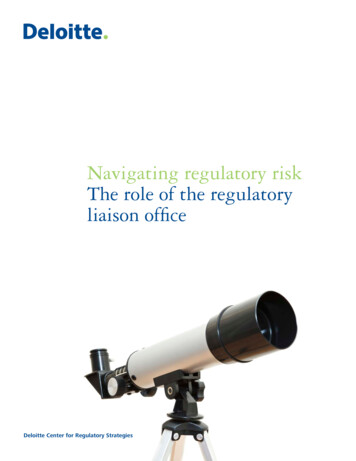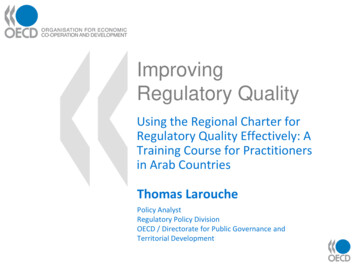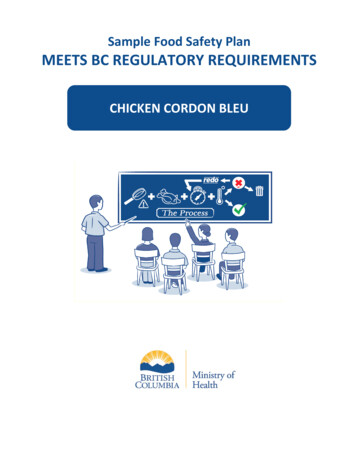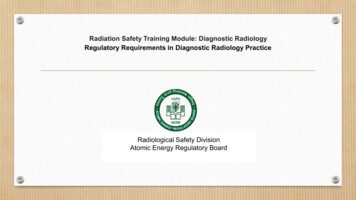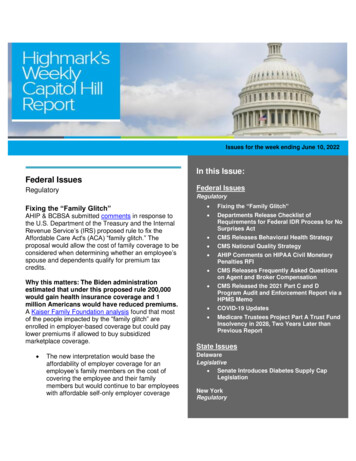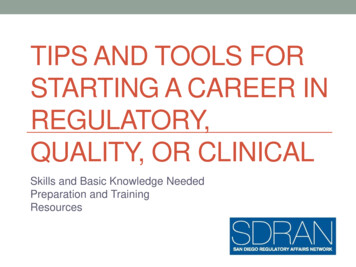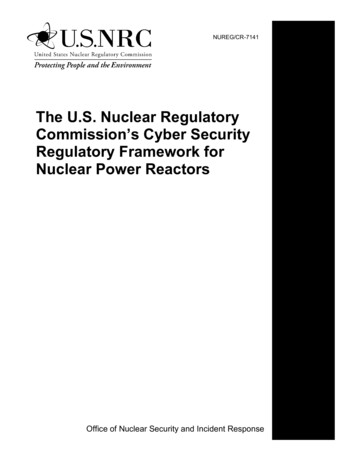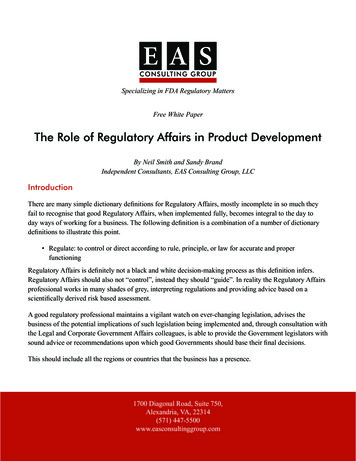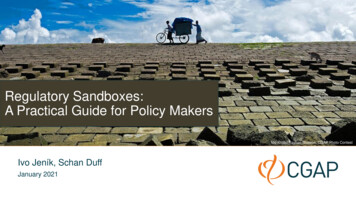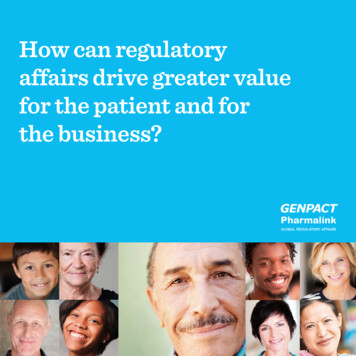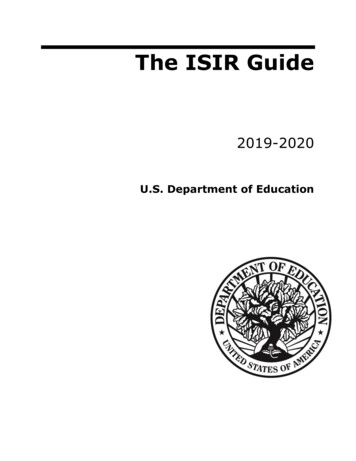
Transcription
1State and Federal RegulatoryRequirementsBasics of Infection Prevention2-Day Mini-Course
2Objectives Describe national, state and local regulatory bodies thatoversee infection prevention and HAI public reporting Describe policy decisions and requirements for publicreporting of HAI Discuss interpretation of California statutes andregulations Review current infection control-related regulations
3HAI Public Reporting Policies Driven by Callfor Transparency Public disclosure intended as driver for infectionprevention; encourages healthcare providers to takeaction Public reporting favored by consumers as means toassess quality of healthcare Better informed public can drive demand for higherquality healthcare Assumption: lower costs to hospitals and societyCalifornia, like many other US states, passed HAIpublic reporting laws for hospitals in 2006 & 2008
4
5Health Care Regulatory AgenciesNationalState-levelLocalCenters for Medicare &Medicaid Services (CMS)California Department ofPublic Health Licensing &Certification Reportable Diseasesand conditions Medical Waste ProgramYour local Health Officerand Health DepartmentOccupational Health andSafety Administration(OSHA)Cal-OSHAEnvironmental HealthCommunicable Diseasesreporting
6Centers for Medicare & Medicaid Services(CMS) – Federal Oversight CMS provides health insurance through Medicare,Medicaid Social Security Act (SSA) requires meeting Conditions ofParticipation (COP) in order to receive Medicare andMedicaid funds SSA Section 1861 “Surveys and certifies” health care facilities, includingnursing homes, home health agencies, and hospitals
7CDPH Licensing and Certification (L&C) –State Oversight Headquarters - Sacramento, CA 13 District Offices plus LA County (5) 600 Health Facility Evaluator Nurses License over 30 different facility types, including General Acute Care Hospitals Long Term Care Facilities (LTCF) Primary Care Clinics Ambulatory Surgery Centers
8Accreditation AgenciesHospital Accrediting Agencies Private, independent accreditation organizations withstandards; certify compliance with CMS requirements TJC – The Joint Commission (formerly JCAHO) NIAHO – National Integrated Accreditation for HealthcareOrganizations (DNV Healthcare) HFAP - Healthcare Facilities Accreditation ProgramAmbulatory Surgery Center Certification American Association of Ambulatory Surgery Centers (AAASC) American Association for Accreditation of Ambulatory SurgicalFacilities (AAAASF) Accreditation Association for Ambulatory Health Care (AAAHC)
9Relationships TJC certifies (“Deems”) to CMS that hospitals licensedin California meets federal requirements 80% hospitals accredited by TJC Otherwise, State Agency (L&C) certifies to CMSregulations (via a contract with CMS) Consolidated Accreditation and Licensing (CALS)surveys – jointly with TJC L&C surveys enforce state laws (HSC 1188) andregulations (CCR Title 22)
10*AFL 11-01 Patient Safety Licensing Survey,www.cdph.ca.gov/PROGRAMS/LNC/Pages/PSLS* GACH – General Acute Care Hospital including LTACH(Long Term Acute Care Hospitals)
11Non-Regulatory “Influencers” Centers for Disease Control and Prevention (CDC) HICPAC: Healthcare Infection Control PracticesAdvisory Committee NHSN: National Healthcare Safety Network The Joint Commission (TJC) added Institute for Healthcare Improvement (IHI) National Quality Forum (NQF) Professional organizations and societies (SHEA, APIC,CSTE, IDSA)
12
13Federal CMS Title 42 RegulationsSubchapter G Standards and CertificationPart 482 Conditions of Participation For Hospitals482.42 Condition of Participation: Infection ControlPart 483 Requirements For States And LTCF483.65 Condition of Participation: Infection ControlPart 484 Home Health ServicesPart 493 Laboratory RequirementsPart 494 Conditions for Coverage for End-stage RenalDisease Facilities
14Part 42 Subpart C - Basic Hospital Functions§ 482.21 Quality Assurance§ 482.22 Medical Staff§ 482.23 Nursing services§ 482.24 Medical record services§ 482.25 Pharmaceutical services§ 482.26 Radiologic services§ 482.27 Laboratory services§ 482.28 Food and Dietetic services§ 482.31 Utilization review§ 482.41 Physical environment§ 482.42 Infection Control§ 482.43 Discharge planning§ 482.45 Organ, tissue, and eye procurement
15Part 43 Subpart B - Requirements for LongTerm Care 40483.45483.55483.60Basis and scope.Definitions.Resident rights.Admission, transfer and discharge rights.Resident behavior and facility practices.Quality of life.Resident assessment.Quality of care.Nursing services.Dietary services.Physician services.Specialized rehabilitative services.Dental services.Pharmacy services.§ 483.65 Infection control.§ 483.70 Physical environment.§ 483.75 Administration.
16CMS CoP Interpretive Guidelines for InfectionControl – READ THEM! Hospitals must be sanitary Have active IC Program and someone overseeing it Surveillance must be systematic Infections must be “logged” Leadership must Ensure problems identified by IC are addressed Take responsibility for corrective action plans whenproblems identifiedComplete interpretive guidelines (14 pages) on APIC website.Google “APIC interpretive guidelines”. Link also on slide 18
17Finding Federal Regulations Centers for Medicare and Medicaid Services (CMS)http://www.cms.hhs.gov/ Regulations & sp Hospital Centerhttp://www.cms.hhs.gov/center/hospital.asp Conditions of Participations (CoPs)http://www.cms.hhs.gov/CFCsAndCoPs/06 Hospitals.asp Interpretive ce/Guidance/Transmittals/downloads/R37SOMA.pdf
CMS HAI Reporting Requirements - via NHSNCMS Reporting ProgramHospitalInpatient QualityReporting (IQR)ProgramHospital OutpatientQuality Reporting(OQR) ProgramESRD QualityIncentiveProgram (QIPHAI EventReporting SpecificationsReporting StartDateCLABSIAdult, Pediatric, and Neonatal ICUsJanuary 2011CAUTISSI:COLOSSSI:HYSTMRSA Bacteremia LabID EventC. difficile LabID EventHealthcare Personnel InfluenzaVaccinationAdult and Pediatric ICUsInpatient COLO ProceduresInpatient HYST ProceduresFacWideINFacWideINJanuary 2012January 2012January 2012January 2013January 2013All Inpatient Healthcare PersonnelJanuary 2013Medicare Beneficiary NumberAll Medicare Patients Reported intoNHSNJuly 2014CLABSIAdult & Pediatric Medical, Surgical, &Medical/Surgical WardsJanuary 2015CAUTIAdult & Pediatric Medical, Surgical, &Medical/Surgical WardsJanuary 2015Healthcare Personnel InfluenzaVaccinationAll Outpatient Healthcare PersonnelOctober 2014Dialysis Event (includes Positive bloodculture, IV antimicrobial start, andsigns of vascular access infection)Outpatient Hemodidalysis FacilitiesJanuary 2012All Healthcare PersonnelOctober 2015Healthcare Personnel MS/CMS-Reporting-Requirements.pdf20
CMS HAI Reporting Requirements - via NHSNCMS Reporting ProgramLong Term Care ehabilitationFacility QualityReporting(IRFQR) ProgramAmbulatory SurgeryCenters Quality Reporting(ASCQR) ProgramPPS-Exempt Cancerhospital Quality Reporting(PCHQR) Program21HAI EventReporting SpecificationsCLABSIAdult & Pediatric LTAC ICUs & WardsReporting StartDateOctober 2012CAUTIHealthcare Personnel InfluenzaVaccinationMRSA Bacteremia LabID EventAdult & Pediatric LTAC ICUs & WardsOctober 2012All Inpatient Healthcare PersonnelOctober 2014FacWideINJanuary 2015C. difficile LabID EventFacWideINJanuary 2015VAEAdult LTAC ICUs and WardsJanuary 2016CAUTIHealthcare Personnel InfluenzaVaccinationAdult & Pediatric IRF WardsOctober 2012All Inpatient Healthcare PersonnelOctober 2014MRSA Bacteremia LabID EventFacWideINJanuary 2015C. difficile LabID EventFacWideINJanuary 2015Healthcare Personnel InfluenzaVaccinationAll Inpatient Healthcare PersonnelOctober 2014CLABSIAll Bedded Inpatient LocationsJanuary 2013CAUTIAll Bedded Inpatient LocationsJanuary 2013SSI:COLOInpatient COLO ProceduresJanuary 2014SSI:HYSTInpatient HYST ProceduresJanuary 2014Inpatient PsychiatricHealthcare Personnel InfluenzaAll Inpatient Healthcare Personnelfacility Quality ReportingVaccination(IPFQR) Program*Long Term Care hospitals are called Long Term Acute Care Hospitals in NHSNOctober 2015
22CMS – 2010 Affordable Care Act Established hospital value-based purchasing plan (HVBP)that rewards hospitals with payments for the quality ofcare provided beneficiaries Reimbursement was based on participation; is now shifting by0.25% annually over 5 year period to a maximum withholdingof 2% Medicare reimbursement Current reduction is 1% Medicare reimbursement Hospitals are ‘scored’ according to Final Rule: 74% or belowwill not lose or gain. For scores greater than 75%, hospital willbe subject to a payment reduction Publishes a “Final Rule” periodically updatingrequirements.
21The Joint Commission (TJC) National PatientSafety Goal (NPSG) 7: Reduce Risk of HAITJC certifies (deems) to CMS that GACH licensed in California meets federalrequirements. 80% CA hospitals are TJC-accredited
22
23TerminologyBills Passed by California legislature, make findings anddeclarations If signed by Governor, legislative bills become Statuteor law.Laws related to health become part of the CaliforniaHealth and Safety Code (HSC)23
24Terminology - continuedRegulations Written by the State Executive branch (usually theaffected agency or department, i.e. CDPH) to1. Carry-out promulgation of what a Bill authorizes ordirectly requires a Department of the State to do2. Clarify the requirements of a Bill (far less common)24
25Terminology -continuedAll Facilities Letters (AFL) Letters to communicate with healthcare facilitiesabout law and regulations Sent to inform facilities of a new requirement or achange of requirement Usually incorporate language from the legislation The absence of an AFL does not absolve a facilityfrom complying with the law25
26California Health and Safety Code (HSC) HAI requirements were passed as Senate Bills 739, 1058, 158and 1311 in 2006, 2008 and 2014 HSC sections that contain HAI requirements are: 1188.45–1188.95 (reporting and prevention requirements,including for an antimicrobial stewardship program) 1255.8 (MRSA patient testing) 1279.7 (Hand hygiene program, connector language)To find California laws and regulations:www.oal.ca.govwww.leginfo.ca.gov
27Where to Find AFLs and What They FL.aspxAn All Facility Letter (AFL) is aletter from the Licensing andCertification (L&C) Program tohealth facilities that arelicensed or certified by L&C.The information contained inthe AFL may include changes in requirements inhealthcare, enforcement, new technologies, scope of practice, or general information thataffects the health facility.Examples of Recent AFL Topics:2014 Measles MERS Five on ebola preparedness,FAQ, waste management SB 1311 AntimicrobialStewardship2015 Management of influenza inLTC and congregate livingfacilities
28California Title 22 RegulationsDivision 5 Licensing and Certification of Health Facilities Chapter 1 GACH (General Acute Care Hospital) Article 7 Administration Chapter 2 Acute Psychiatric Hospital Chapter 3 Skilled Nursing Facilities Chapter 4 Intermediate Care Facilities Chapter 7 Primary Care Clinics Chapter 7.1 Specialty Clinics– Article 6. Hemodialyzer Reuse Chapter 12 - Correctional Treatment
29California Code of Regulations – Title 22* Requires a written hospital infection control program forthe surveillance, prevention, and control of infections. Policies and procedures must cover Management of transmission risks within hospitalEducationA plan for surveillance, including management of outbreaksHow to identify biohazardous equipment and materials Oversight of the program is vested in a multidisciplinarycommittee There shall be one designated FTE/200 licensed beds*Title 22, Div 5, Chap 1, Article 7, Sec 70739
30Reportable Diseases and Conditions All cases of reportable diseases shall be reported to thelocal health officer in accordance with Section 2500,Article 1, Subchapter 4, Chapter 4, Title 17, CaliforniaAdministrative Code Defined as events that threaten welfare, safety, or healthof patients, personnel, or visitors
31Cal/OSHADepartment of Industrial Relations -- Division of Occupational Safety and Health -- Cal/OSHA Develops regulations for workplace safety and health Standards Board adopts California regulations must be “at least as effective”as federal regulations
32Cal-OSHA Bloodborne Pathogens (BBP)Standard*Purpose: Ensure employees are protected from potentialexposure to blood/body fluidsIncludes Hierarchy of controls (early identification, engineering controls,administrative policies, personal protective equipment) Safe practices, risk assessment, medical surveillance of employees HBV offered to all employees at risk Post exposure management Training and record keeping*CCR, Title 8, Section 5193
33Cal-OSHA Aerosol-Transmissible DiseasesStandard (ATD)*Inclusive of any disease that could be “transmitted byparticles flying through air and landing in the lungs or onmucous membranes” Aerosol, near-aerosol, droplet modes of transmission Tuberculosis Standard rolled into thisExtends scope of requirement for to settings outsidehospital – across continuum Requires specified levels of respiratory protection for certaindiseases (be familiar w/ appendices)Format, requirements similar to BBP Standard*CCR, Title 8, Section 5199
34Cal-OSHA Respiratory Protection Standard*Any employer that requires a worker to don a respirator musthave a Respiratory Protection Program (RPP)To include How to select and care for respirators Medical screening Fit-testing requirements and methods Training and documentationConcept of RPP was developed initiallyfor use of respirators in industrial settings*CCR, Title 8, Section 5144
35Medical Waste Management Act*Ensures proper handling and disposal of medical wastethroughout CaliforniaBiohazardous WasteSee HSC 117635 for complete definition (a) Laboratory waste, including human or animal specimencultures from medical and pathology laboratories (b) Human surgery specimens or tissue (e) Waste containing discarded materials contaminated withexcretion, exudate, or secretions from humans that arerequired to be isolated by infection control staff, attendingphysician and surgeon, or local health officer*Health and Safety Code 117600
36Medical WasteManagement ActEnforced by CDPH Medical WasteProgramgray counties-or Local Departments ofEnvironmental Healthwhite counties
37Summary There are many mandates and influencers that affectinfection prevention practices. The IP must be familiar with these and facilitatecompliance in his/her facility.Copies or links to this information can be found on theHAI Program websitewww.cdph.ca.gov/HAI
38HAI Prevention NowWe no longer accept that 2/3 infections are a cost ofreceiving healthcare. Infections are ever more theexception, not the expected outcomeWe know there are bundles of evidence-based strategiesand new technology that, when properly applied in asafety culture, can significantly enhance patient safetyBy apportioning (or reapportioning) dollars to buy specifiedoutcomes, the mantras of prevention and patient safetyhave become a higher priority to healthcare providersWe remain committed to our goal:healthier, safer patients!
39Questions?For more information, please contact anyHAI Liaison Team member.Thank you
Private, independent accreditation organizations with standards; certify compliance with CMS requirements TJC -The Joint Commission (formerly JCAHO) NIAHO -National Integrated Accreditation for Healthcare Organizations (DNV Healthcare) HFAP - Healthcare Facilities Accreditation Program Ambulatory Surgery Center Certification
